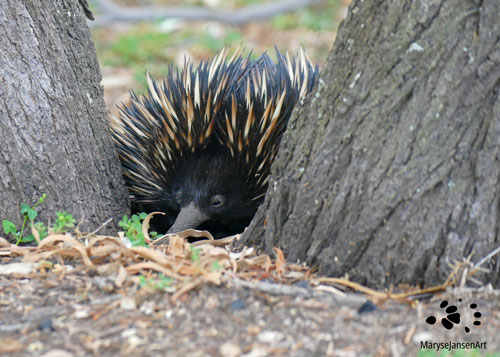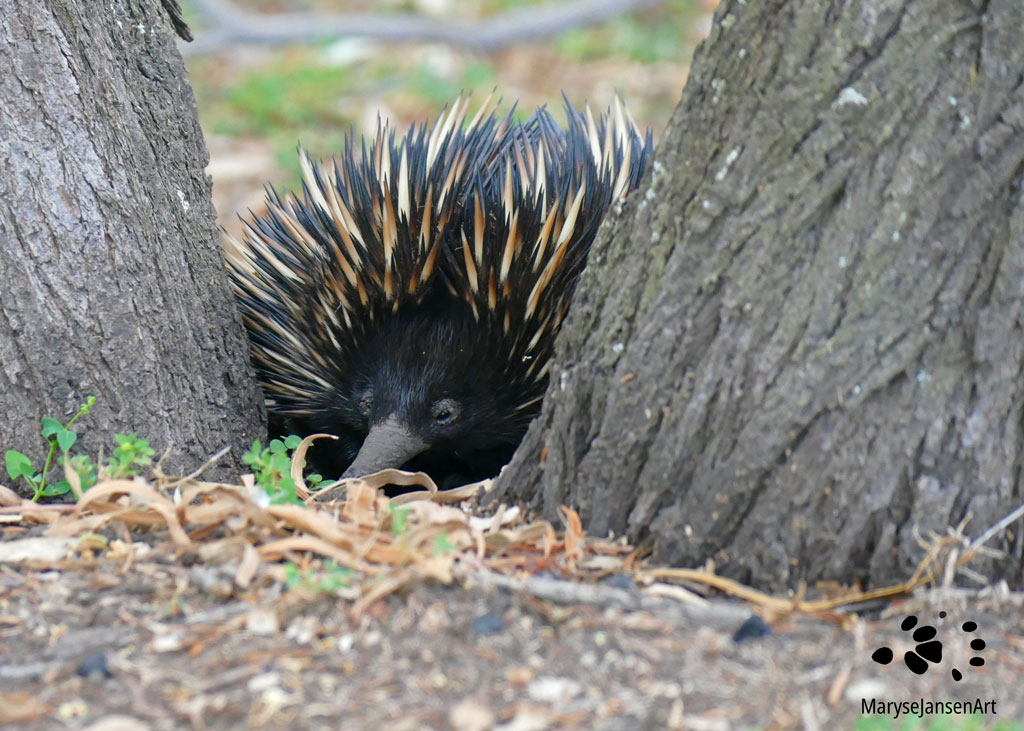Wildlife Photography with marysejansenart
If I can’t see you, you can’t see me!

Table of Contents
Campsite visitor
The sun is going down, the mozzies are coming out and the temperature is dropping. I put on some warmer clothes and some mozzie-spray. It is late afternoon, I’m on a campsite in south-east Queensland, getting ready to cook dinner. It’s only autumn but we’re travelling inland and the nights get quite chilly already. Suddenly this cute Echidna comes waddling by!
I jump up and get my camera. Of course I give the animal a really wide berth as to not disturb it. It is very important as an observer or photographer to try and not interfere with the natural behaviour of wildlife!
Despite my efforts, the echidna decides it’s not to keen on our presence at all anyway. It waddles up between two tree stumps, sticks it’s snout in between and continues to sit very still as if it is thinking: ‘if I can’t see you, you can’t see me!’ Just like a toddler playing hide and seek! It is absolutely adorable!
It just sits there and doesn’t move. I take my photos and then we go about our business and cook dinner and eat. Of course I keep a curious watch from the corner of my eye on how our little friend is going. Yep, it’s still there! After dinner we go for a little walk and when we come back the echidna is finally gone!
Hiding is a typical behaviour for echidnas
This behaviour is actually quite typical for an echidna. On another encounter I had, during a local bush walk, I heard a rustle in the undergrowth next to the path. I stopped and looked to see what was making the noise. It was an echidna and it was burying itself into the leaf litter. This way it was hoping to be protected from the strange human passerby. Once in position it would’ve been very hard to spot it if I hadn’t known it was there. The multi-coloured spikes gave it excellent camouflage!
Whenever echidnas feel threatened they tend to curl up in a ball (in a similar way to hedgehogs) or try to bury themselves, using their sharp spikes as a defence. It’s all they can do really as they are extremely slow moving. Their funny gait is caused by the fact that their back feet have a backwards orientation. They generally waddle around at 1km/h and at top speed they might make 2.3km/h! Not exactly a good speed to help them run for cover. They are quite shy animals and the least sign of possible danger will send them into their ‘hiding’ position, trusting their spikes to ward off predators.
Monotremes
Echidna’s are a unique type of mammal, called a monotreme! A monotreme is an egg-laying mammal: this means they lay eggs and suckle their young! Just like the platypus. Echidna and platypus are the only two monotremes in the world!!
(Read my earlier post ‘Surprise at Sunrise at Lake Tinaroo’ to learn more about the platypus.)
There are two species of echidna in the world: the Long-beaked Echidna and the Short-beaked Echidna. In this post I talk about the Australian species: the Short-beaked Echidna. The Long-beaked Echidna lives only in the highlands of New Guinea, and the Short-beaked Echidna can be found in the lowlands of New Guinea as well as in the whole of Australia.
Echidnas in the ecosystem
The Short-beaked Echidnas are not picky about their habitat. They can be found almost everywhere in Australia from snow covered mountains to deserts and even in urban areas. Their shy behaviour and good camouflage makes it hard to see them though.
Echidnas are very useful in their ecosystem because they are are constantly digging and turning over the soil! With their short front legs and long claws they are well equipped to be excellent and powerful diggers. Their back feet are pointed backwards which helps in pushing away the soil when they’re burrowing. As a consequence of all this digging and soil turning it’s easier for the soil to take up water and for plants to grow.
Digging for termites
Of course the echidna has another agenda: food! Their favourite food is ants, especially termites. But they will also take worms and beetle-larvae. To get to these delicacies some digging is required! They have another handy tool to assist in the process of breaking up logs and termite mounds: their snout. The snout of the Short-beaked Echidna is still considerably long at about 7-8cm! It’s a bit stiff and therefore really helpful in the digging process! Although it is often called a beak, it is actually a nose.
Echidnas have a very good sense of smell which helps them detect their food so they know where to dig. On top of that they also have electro receptors on their nose, which also help them detect their prey. Once their meal is exposed they can use their long sticky tongue that extends beyond their snout to collect the yummy termites.
Seeing and being seen
Depending on the climate they live in, the season and the sources of food that are available they can be active on various times of the day and night. Here in Queensland they are mainly active during the cooler hours of the day. Usually the light is very low or it is even already dark on the few occasions that I have seen one. The echidnas don’t mind because they barely rely on their eyesight. They can’t see very well at all. In those circumstances chances are slim that us people will see them, so maybe they are right after all: they can’t see us, we can’t see them!
If you are interested in purchasing ‘If I can’t see you, you can’t see me!’ or would like to see what it looks like on the various products, please head to my shop.


